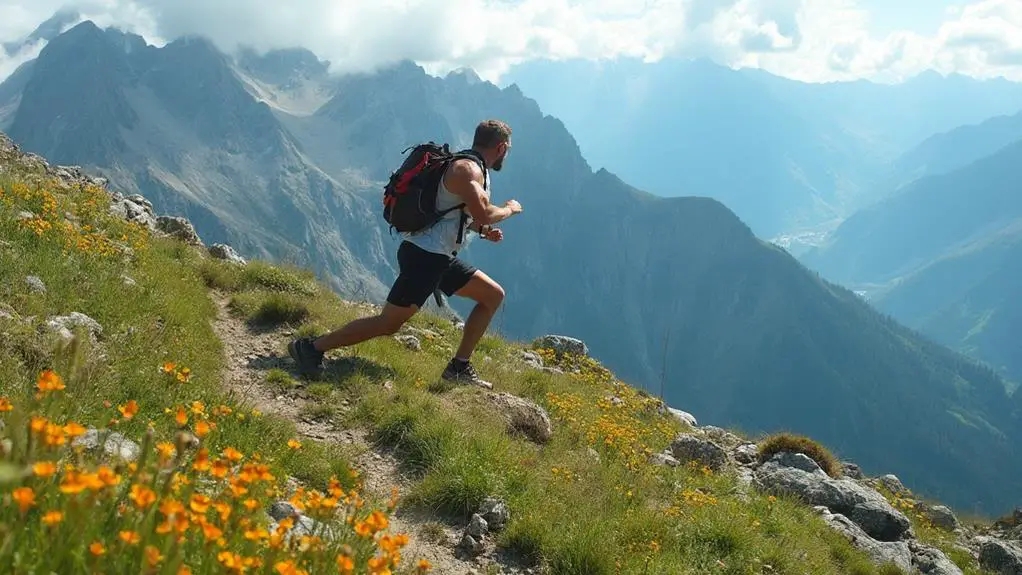Building leg strength is essential for fell walkers aiming to enhance performance and prevent injuries. Key exercises include goblet squats, step-ups, and downhill lunges. Goblet squats improve quad, hamstring, and glute strength, while step-ups enhance stability and mimic natural hill climbing. Downhill lunges target the quadriceps, important for descent stability. Complement these with core stability exercises like planks, and use a Stairmaster to boost cardiovascular endurance. Training 3-4 times weekly, focusing on proper technique and gradual progression, guarantees peak results. Further insights into effective strategies will enhance your hiking experience and satisfaction.
Key Takeaways
- Goblet squats enhance quads, hamstrings, and glutes, crucial for hiking strength and endurance.
- Step-ups mimic hill climbing, improving leg strength, stability, and endurance.
- Downhill lunges strengthen quadriceps for stability during steep descents and reduce injury risk.
- Core stability exercises like planks enhance balance and overall hiking performance.
- Stairmaster sessions boost cardiovascular endurance, simulating uphill climbing for stronger legs.
Importance of Leg Strength
In the domain of hiking, leg strength stands as a foundational pillar for both performance and safety. Strong leg muscles, particularly the quadriceps, hamstrings, and calves, are essential for fell walking, where steep inclines and uneven terrains demand significant power and endurance.
Leg endurance enables hikers to traverse longer distances with reduced fatigue, an essential factor in maintaining a steady and safe pace during extended treks.
Moreover, enhanced leg strength is integral to injury prevention by providing the necessary support and stability on challenging hikes and descents. By fortifying the lower extremities, hikers can minimize the risk of sprains and strains, especially in unstable environments.
Stronger leg muscles also facilitate the comfortable carrying of heavy backpacks, as they efficiently distribute and manage additional loads, contributing to overall hiking efficiency.
Anatomically, targeting major leg muscle groups through specific exercises promotes effective muscle recovery, allowing hikers to engage in frequent trekking activities without compromising their physical well-being.
Ultimately, a robust lower body is indispensable for optimizing hiking performance, enabling individuals to enjoy more strenuous walks with confidence and less susceptibility to injury, enhancing overall enjoyment and satisfaction in the hiking experience.
Goblet Squats Technique

Mastering the technique of goblet squats is fundamental to effectively targeting the quads, hamstrings, and glutes, thereby enhancing stability and power for hikers.
Proper form involves holding a kettlebell or dumbbell close to the chest, with elbows down, feet hip-width apart, and maintaining weight in the heels as you squat to parallel.
Progressively increasing the weight used in the exercise, while avoiding common mistakes such as letting the knees collapse inward, can greatly boost leg strength and core stability, both essential for traversing uneven terrains.
Proper Form Essentials
Goblet squats are a fundamental exercise to boost leg strength and stability, particularly beneficial for hikers tackling varied terrains. Among squat variations, the goblet squat is especially advantageous due to its emphasis on maintaining proper form while engaging multiple muscle groups.
Begin by standing with feet hip-width apart, holding a kettlebell or dumbbell close to the chest, with elbows pointed down. This setup helps distribute weight efficiently, promoting a balanced posture. Resistance bands can complement this exercise by adding additional lateral resistance, further challenging stabilizing muscles.
Engage the core and keep the chest raised as you initiate the squat by bending the knees and pushing the hips back. Descend until your thighs are parallel to the floor, ensuring the knees track over the toes to reduce joint strain. The controlled movement is essential for targeting the quadriceps, hamstrings, and glutes effectively while minimizing injury risk.
To return to the starting position, push through your heels, fully extending the hips and knees. This movement pattern aids in developing the strength and endurance required for rigorous hiking activities. Gradually increasing weight, while maintaining proper form, enhances the muscle adaptation process, vital for fell walking.
Weight Progression Tips
Enhancing leg strength for hikers through effective weight progression in goblet squats requires a methodical approach to balance muscle adaptation and injury prevention.
Begin with a light kettlebell or dumbbell to prioritize mastering technique, thereby minimizing the risk of injury. As proficiency in form is established, initiate a gradual weight increase by 5-10% weekly. This incremental approach enables muscle fibers to adapt and fortify without undue stress.
Aim for each set to include 8-15 repetitions, ensuring the latter repetitions challenge muscular endurance while maintaining proper form. This rep range is ideal for fostering hypertrophy and muscular endurance, essential for the demands of fell walking.
As strength levels improve, consider set variation as a form of progressive overload. By adding additional sets or increasing repetitions, hikers can stimulate further muscle growth and endurance without merely focusing on increasing weights.
A consistent training regimen, performed 3-4 times weekly, is imperative for sustained adaptations in muscle strength and endurance. This frequency allows adequate recovery, promoting muscular repair and growth.
Common Mistakes Avoidance
A common pitfall in executing goblet squats is improper foot positioning, which can undermine balance and form. Ensuring that your feet are positioned hip-width apart is vital to maintaining stability and avoiding common squat mistakes. The weight should be primarily in your heels, allowing for ideal balance and protecting the knees from unnecessary strain.
This proper distribution of weight is essential for balancing weight effectively, especially as you descend into the squat.
To minimize the risk of injury and maximize the benefits of goblet squats, consider the following key points:
- Depth Control: Descend until your thighs are parallel to the floor. Avoid excessive forward lean to keep your spine aligned and your core engaged.
- Weight Management: Prioritize maintaining form over increasing weight. Gradually increase the kettlebell or dumbbell weight as strength improves, ensuring stability is not compromised.
- Core Engagement: Maintain a straight back throughout the movement. Engaging your core provides stability and prevents unwanted strain on the lower back.
Mastering Step-Ups

Step-ups are a fundamental exercise for enhancing leg strength, particularly targeting the quadriceps and gluteal muscles, which are essential for uphill hiking.
Proper technique involves using a platform of 10-16 inches, ensuring full hip extension at the top, and maintaining an upright torso while driving through the heel to optimize muscle engagement and minimize injury risk.
To advance the exercise, gradually increase the step height or incorporate weights, alternating legs with each repetition to promote balanced muscle development and prevent overuse injuries.
Proper Step-Up Technique
Mastering step-ups is a fundamental component of building leg strength, particularly for hikers seeking to improve their endurance and stability on the trail. Understanding the proper step-up technique is essential for maximizing its effectiveness and minimizing injury risk.
To begin, select a sturdy box or platform, ideally between 10-16 inches high for beginners, guaranteeing stability. The height can be adjusted as your strength progresses, allowing for various step up variations to target different muscle groups and enhance overall strength.
Focus on pushing through the heel of the leading foot, which effectively engages the quadriceps and gluteal muscles. This action is pivotal in reaping the step up benefits, contributing to muscular endurance essential for hiking.
Maintain a controlled descent, alternating legs with each repetition to promote balanced strength development and prevent muscle imbalances.
To guarantee proper form:
- Keep your upper body aligned, avoiding any forward lean, and maintain a straight back.
- Engage your core muscles throughout the movement for enhanced stability.
- Gradually increase the challenge by elevating the step height or incorporating weights like dumbbells or kettlebells.
Benefits of Step-Ups
Regularly integrating step-ups into your exercise regimen provides significant benefits for hikers, particularly regarding enhancing leg strength and stability. Step-ups primarily target the quadriceps and gluteal muscles, which are essential for the strength needed to ascend steep terrains commonly encountered in fell walking. By engaging these muscle groups, hikers can develop the power required for climbing, thereby improving overall hiking performance.
Performing step-ups with step up equipment, such as a sturdy box or staircase, serves to enhance balance and stability. These components are critical for maneuvering the uneven surfaces typical of outdoor trails. The exercise mimics the biomechanical movement pattern of hill climbing, effectively preparing muscles for real-world uphill challenges.
Incorporating step up variations, such as adjusting the height of the step or adding resistance through weights, can further intensify the workout. This progression supports increased muscle strength and endurance, fundamental attributes for sustained hiking activities.
To maximize the benefits, it is recommended to execute step-ups with controlled movements, guaranteeing full hip extension at the apex of the step while engaging the core for enhanced stability. This careful execution assures the exercise is not only effective but also safe, preventing potential injuries.
Step-Up Progression Tips
Building upon the foundational benefits of step-ups, hikers seeking to boost their leg strength can focus on mastering step-up progression techniques.
Begin with a step height of 10-16 inches; this promotes proper form and builds confidence in beginners. Emphasizing the importance of form, guarantee each step-up engages the glutes and quadriceps effectively by pushing through the front heel. This movement encourages full hip extension, essential for balanced strength development.
Alternating legs with each repetition is important to maintain leg balance, preventing muscle imbalances that could impair hiking performance.
To advance in step-up progression:
- Gradually increase step height: Once you can perform 10-15 repetitions with correct form, raise the step height or incorporate added resistance like dumbbells or kettlebells.
- Consistency in routine: Integrate step-ups 3-4 times weekly, targeting 3 sets of 8-12 repetitions per leg, optimizing strength gains for uphill walking.
- Focus on balanced strength: By alternating legs, you guarantee even muscle development and improved stability.
Patient-centered progression in step-ups is significant for hikers aiming to conquer challenging terrains.
Through structured techniques, hikers can substantially boost their leg strength, promoting both endurance and resilience during fell walking.
Downhill Lunges Benefits

For hikers aiming to enhance their leg strength and stability, incorporating downhill lunges into their training regimen offers significant benefits. Downhill lunges primarily target the quadriceps, fundamental for maintaining stability and control during steep descents in fell walking. This exercise involves eccentric loading, effectively strengthening muscles as they lengthen, which is crucial for managing downhill forces. Additionally, downhill lunges activate stabilizer muscles and engage the core, contributing to improved balance and reducing the risk of falls on uneven terrain.
Incorporating downhill lunges into a regular exercise routine not only bolsters muscle endurance but also prepares the body for the unique demands of descending hills. This preparation is essential for preventing injuries and tackling longer, more challenging trails without succumbing to fatigue. Gradually increasing the distance covered in downhill lunges can enhance both strength and adaptability to the varying elevations encountered in fell walking.
| Benefit | Description |
|---|---|
| Quadriceps Strengthening | Targets muscles essential for stability during descents |
| Eccentric Loading Preparation | Conditions muscles for downhill forces, reducing injury risk |
| Enhanced Balance and Endurance | Engages core and stabilizers, improving overall balance and muscle stamina |
Thus, downhill lunges are a crucial component of an all-encompassing training program for hikers seeking improved performance and safety on rugged terrains.
Core Stability Exercises

In the domain of hiking, core stability exercises are indispensable for enhancing balance and coordination on uneven terrains. Core engagement is vital as it helps maintain proper posture, reducing strain on the back and minimizing injury risks. Strengthening these muscles guarantees hikers can effectively traverse through challenging landscapes.
Key exercises that provide notable stability benefits include:
- Planks: Engage multiple muscle groups, enhancing overall stability. They are effective for improving endurance and should be performed with attention to maintaining a neutral spine.
- Hanging Knee Raises: Specifically target the abdominal muscles, essential for core engagement. These exercises support lumbar stability and are beneficial for maintaining posture during prolonged hikes.
- Russian Twists: Incorporating rotational movements, these exercises notably enhance core strength and stability. They are particularly advantageous for maneuvering steep inclines or declines by improving rotational control.
Performing core stability exercises 2-3 times per week is recommended, focusing on control and form to maximize benefits. This regimen not only strengthens the core but also promotes endurance, necessary for extended hiking sessions.
Stairmaster for Cardio

The Stairmaster frequently emerges as an indispensable tool for hikers aiming to improve both leg strength and cardiovascular endurance. This equipment effectively simulates uphill climbing, a core component of fell walking, making it ideal for developing the quadriceps, hamstrings, and calves. For beginners, a 20-minute session—starting with a five-minute warm-up—can help acclimate the body to increased intensity. Over time, gradually extending the duration and intensity of workouts can greatly enhance Stairmaster endurance, enabling hikers to manage longer and steeper trails with confidence.
Incorporating Stairmaster intervals, which alternate between high-intensity stepping and recovery periods, can further boost cardiovascular fitness, preparing hikers for the physical demands of challenging terrains. Regular sessions not only increase stamina but also fortify critical muscle groups, thereby reducing the risk of injuries and enhancing stability on uneven surfaces.
| Workout Component | Description |
|---|---|
| Warm-up | 5 minutes at moderate pace |
| Beginner Session | 20 minutes total, including warm-up |
| Interval Training | High-intensity steps followed by recovery |
| Muscle Groups Targeted | Quads, hamstrings, calves |
Training Frequency Tips

Recognizing the significance of a well-structured training plan, hikers should aim to engage in strength-building exercises 3-4 times per week to optimize leg development and overall hiking performance.
Each session should be carefully planned to last between 30-60 minutes, guaranteeing a balance between endurance and muscle hypertrophy. A consistent training schedule not only facilitates muscle adaptation but also reduces the risk of overuse injuries.
To further enhance muscular development and prevent plateauing, it is essential to integrate workout variety into the routine.
- Training Intensity: Gradually increase weights or resistance to prevent burnout and guarantee progress.
- Session Duration: Maintain focused workouts within the 30-60 minute range for maximum efficacy.
- Rest Days: Schedule rest days to allow muscles to recover and strengthen, reducing injury risk.
Flexibility and Recovery

Flexibility and recovery form the cornerstone of effective leg strength training for hikers, facilitating improved performance and reduced injury risk. Regular post-workout stretching techniques are essential in enhancing flexibility, reducing muscle tension, and maintaining mobility, which is necessary for the dynamic demands of fell walking.
Stretching not only alleviates tightness but also prepares the muscles for subsequent activities, ensuring a safer hiking experience.
Incorporating yoga or Pilates into a hiker's routine can greatly bolster core strength and balance. These practices target the stabilization muscles, important for traversing uneven terrains, thereby minimizing the likelihood of falls.
Additionally, balance drills such as one-leg stands and balance board exercises are effective in enhancing trail stability, promoting proprioceptive awareness and reducing the incidence of injuries.
Recovery strategies are equally important, emphasizing the importance of adequate rest for ideal muscle repair. Engaging in active recovery, like low-intensity walking and stretching, aids in facilitating blood flow and nutrient delivery to fatigued muscles.
This approach not only supports muscle repair but also contributes to overall strength enhancement. By integrating these evidence-based strategies, hikers can achieve a balanced approach to training, improving performance while safeguarding against injury.
Nutrition for Hiking

Fueling the body with a balanced diet is paramount for hikers aiming to optimize their performance and endurance on trails. A diet rich in carbohydrates, proteins, and healthy fats is essential. Carbohydrates serve as the primary energy substrate during endurance activities such as fell walking, which underscores the importance of strategic meal planning.
Integrating nutrient-dense snacks, such as nuts, seeds, and energy bars, can help maintain energy levels and stave off fatigue during hikes.
Hydration strategies are equally important. Consuming at least half of one's body weight in ounces of water daily is recommended. For prolonged treks, electrolyte-rich drinks should be incorporated to replace lost minerals and prevent dehydration, which can detrimentally impact strength and endurance.
Post-hike nutrition is essential for recovery. Consuming a blend of protein and carbohydrates, such as chicken with quinoa or a smoothie with protein powder, aids in muscle repair and replenishes glycogen stores.
Consider the following nutritional guidelines for effective hiking:
- Meal Planning: Prioritize carbohydrates and proteins pre- and post-hike.
- Hydration Strategies: Maintain hydration with water and electrolytes.
- Snacking: Choose energy-sustaining snacks to prevent fatigue.
Monitoring hunger and thirst cues is essential for sustaining peak performance.
Frequently Asked Questions
How Do I Strengthen My Legs for Hill Walking?
To effectively strengthen legs for hill walking, incorporate squat variations and a lunges routine. These exercises target essential muscle groups, including quads, hamstrings, and glutes, thereby enhancing stability, endurance, and overall locomotor efficiency vital for challenging terrains.
How Do I Get Fit for Fell Walking?
To get fit for fell walking, integrate cardio training and hiking techniques into your regimen. Focus on exercises enhancing cardiovascular endurance, such as hill intervals, and incorporate strength training targeting lower limbs to improve overall hiking performance and safety.
How to Build up Stamina for Hill Walking?
To build stamina for hill walking, incorporate endurance training with interval workouts. This combination enhances aerobic capacity and muscular endurance, optimizing energy utilization and recovery. Aim for consistent sessions, balancing cardiovascular and strength exercises to improve overall performance.
How Do You Strengthen Your Legs When Walking?
To enhance leg endurance and promote muscle recovery when walking, integrate exercises such as goblet squats, downhill lunges, and single-leg calf raises into your routine. These exercises target key muscle groups, enhancing stability and functional strength.
Conclusion
Enhancing leg strength is essential for optimized fell walking performance, reducing injury risk, and improving endurance. Goblet squats, step-ups, and downhill lunges effectively target key muscle groups including quadriceps, hamstrings, and gluteal muscles. Core stability exercises complement these by ensuring proper posture and balance. Incorporating the Stairmaster enhances cardiovascular endurance. A balanced regimen, emphasizing adequate training frequency, flexibility, recovery, and nutrition, forms the foundation of an effective hiking preparation strategy. This holistic approach supports sustained physical health and hiking proficiency.